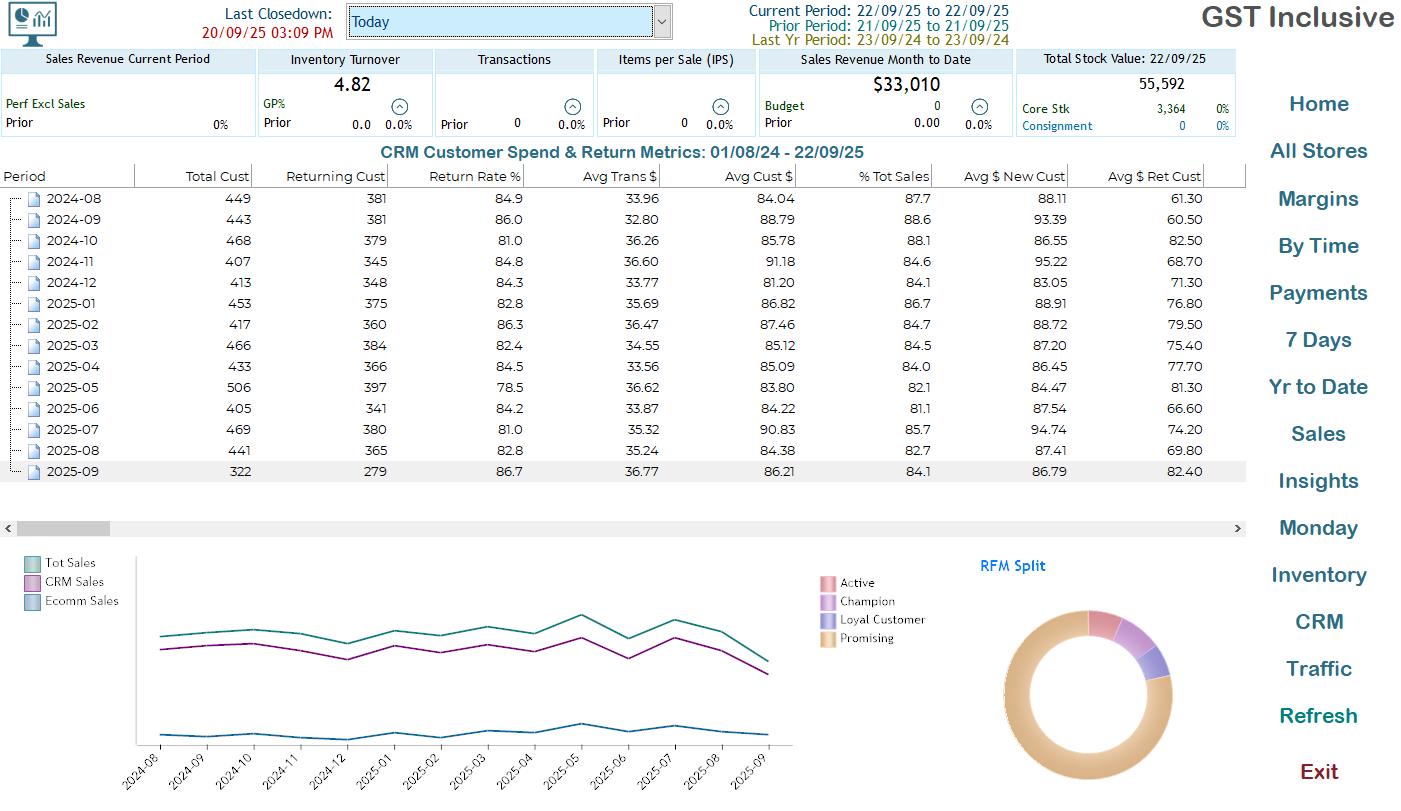CRM
CRM Customer Spend & Return Metrics
This screen shows how your CRM customers are spending over time, and how often they return to make more purchases. It combines key sales figures with customer behaviour, so you can quickly see whether your marketing and loyalty efforts are working.

- CRM Customer Spend & Return Metrics
The table provides detailed customer spend and return information for each month. The main columns are:
- Period – the month and year being reported.
- Total Cust – the total number of CRM customers in that period.
- Returning Cust – how many of those customers came back for another purchase.
- Return Rate % – the percentage of customers who returned.
- Avg Trans $ – the average value of each transaction.
- Avg Cust $ – the average amount spent per customer.
- % Tot Sales – the share of your overall sales that came from CRM customers.
- Avg $ New Cust – average spend by new customers.
- Avg $ Ret Cust – average spend by returning customers.
This breakdown helps you see whether growth is being driven by new customers, returning customers, or both.
- Sales Trend Line Chart
- A visual representation of sales trends over the months.
- Tracks Total Sales, CRM Sales, and Ecommerce Sales.
- Useful for identifying patterns, peaks, and troughs in sales performance.
- Customer Segmentation Pie Chart (RFM)
- The RFM Split is a doughnut chart that groups your customers into segments using RFM (Recency, Frequency, Monetary value). This allows you to target different customer groups with the right strategy.
RFM Segments Explained
- Champions – Your best customers. They buy frequently, spend the most, and purchased recently. Reward them with early access, exclusive offers, or loyalty perks.
- Loyal Customers – Reliable and consistent buyers. They may not spend as much as Champions, but they return often. Keep them engaged with rewards, personalised offers, or membership benefits.
- Active – Customers who buy regularly and have good spending habits, but not as strong as Champions. Continue to nurture them so they don’t drift away.
- Promising – Newer customers who have purchased recently but not often. Encourage them to buy again with onboarding campaigns or introductory offers.
- Needs Attention – Customers who used to buy but are slowing down. Re-engage them with reminders, discounts, or relevant product suggestions.
- Almost Lost – Customers who haven’t purchased for a long time and risk leaving. Win them back with special promotions or personalised outreach.
- At Risk – High-value customers who haven’t purchased recently. These are critical to re-activate, as losing them would have a big impact.
- Previously Loyal – Customers who used to be regular buyers but have stopped. Try targeted win-back campaigns to reconnect.
- Dormant – Customers who have not purchased for a very long time. They may be lost, but it can still be worth testing re-engagement with strong offers or surveys.
Summary
RFM labels help businesses identify customer segments for targeted marketing efforts, aiming to enhance customer retention, engagement, and overall profitability. Each type requires specific strategies to effectively manage and revitalise customer relationships.
How to Use
- Track loyalty: Look at the Returning Cust and Return Rate % to check how well you are keeping customers engaged.
- Compare spend: Review Avg $ New Cust vs Avg $ Ret Cust to see whether new customers are being nurtured into higher-value repeat buyers.
- Monitor trends: Use the sales chart to spot seasonal peaks, dips, or unexpected drops.
- Plan marketing actions: Use the RFM Split to target the right group with the right campaign (e.g. reward “Champions”, re-activate “Almost Lost”, encourage “Promising”).
Key Insights
- The return rate fluctuates across the months, indicating changes in customer loyalty.
- E-commerce sales are a significant driver of total sales during the examined period.
- A noteworthy portion of customers falls into the 'Promising' category, suggesting growth opportunities for enhanced engagement.